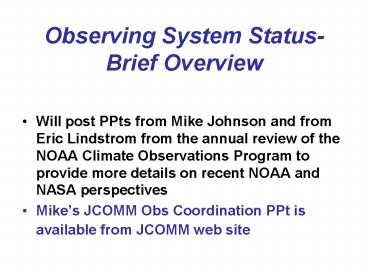Observing System Status- Brief Overview - PowerPoint PPT Presentation
1 / 23
Title:
Observing System Status- Brief Overview
Description:
Observing System Status-Brief Overview Will post PPts from Mike Johnson and from Eric Lindstrom from the annual review of the NOAA Climate Observations Program to ... – PowerPoint PPT presentation
Number of Views:105
Avg rating:3.0/5.0
Title: Observing System Status- Brief Overview
1
Observing System Status-Brief Overview
- Will post PPts from Mike Johnson and from Eric
Lindstrom from the annual review of the NOAA
Climate Observations Program to provide more
details on recent NOAA and NASA perspectives - Mikes JCOMM Obs Coordination PPt is available
from JCOMM web site
2
Keeping it going
- There has been some progress in some nations
toward sustaining in situ and satellite observing
efforts. - However most efforts are still supported via
research agency funding and the efforts of
research oceanographers - Demonstrations of effectiveness of system will be
a continuing need - INDICES!
3
In Situ System
- Particular progress w. real time Tide gauges and
pCO2 - Incremental progress in some other elements
- Increased awareness of challenges of maintaining
global distribution of both surface drifters and
float - Some historical data issues w. XTBs and some Argo
floats - New GOOS coastal technical panel
4
Celebrating the Past, Observing the Present,
Predicting the Future Adjusted Program
Components that will be completed by 2013
Goal
2003
2004
2005
2007
2006
2008
2009
2010
2011
2012
2013
180
Real-time Stations, Initial GCOS Subset
180
180
180
172
162
Tide Gauge Stations
102
152
127
69
67
79
1250
1250
1250
1250
1250
1250
1250
1250
1250
779
787
Number of buoys
975
Surface Drifting Buoys
132
86
117
115
112
Number of moorings
119
118
79
83
103
Tropical Moored Buoys
91
97
51
51
High resolution frequently repeated lines
occupied
51
51
51
46
41
44
41
Ships of Opportunity
27
26
39
3000
3000
3000
3000
3000
3000
3000
3000
Number of floats
923
2557
2240
1500
Argo Floats
Number of observatories and ocean reference
stations
87
Ocean Reference Stations
42
43
46
47
41
58
57
37
58
58
49
Ice buoys, drifting and moored stations, transects
73
Arctic Ocean System
18
24
21
21
55
55
13
12
55
55
38
Repeat Sections completed, one inventory per 10
years
37
37
34
31
29
Ocean Carbon Network
22
26
4
17
20
9
15
882
Days at sea (NOAA contribution)
582
582
Dedicated Ship Time
582
582
492
522
492
458
458
370
468
Base Budget FY 08 Presidents Budget Program
Planning
Representative milestones including international
contributions
100
98
89
81
72
System Complete
63
89
59
59
81
55
57
72
45
48
67
68
68
69
63
Total System
59
62
58
59
59
56
55
57
55
100 Requirement Program Adjustment
2003
2004
2005
2007
2006
2008
2009
2010
2011
2012
2013
Goal
05/18/07
5
Observing System Monitoring Center Near-real-time
tool for system statistics and data
- Sort by
- Platform type
- Variables being sampled
- Time frame
- Contributing Country
- Drill down for platform metadata and real-time
data.
Test Version 2.00 beta www.jcommops.org/network_s
tatus
6
Status of the System
6279 platforms globally. 2950 U.S. platforms. (
One day snapshot of surface platforms reporting
7
Coming SoonDirect link to performance monitoring
GOOS Requirement for SST 5x5 grid
8
Tropical Moored Buoys
- TAO/TRITON sustained
- PIRATA Extensions implemented
- Indian Ocean Array getting started
9
Argo Profiling Float Array
2849 active floats
10
Note AX08 is Under sampled in FRX Mode
41 of 51 UOT XBT lines now occupied
910 VOS reporting at least 25 obs/month
11
GCOS Climate Reference Network of Tide Gauge
Stations
Establishing the GCOS subset of GLOSS Climate
Reference Stations
GEO-located
By the end of 2007 most of the 170 Climate
Reference Tide Gauge Stations Will Provide Marine
Hazards Warning in Real Time
12
ITF and MOVE in transition to NOAA
NOAA Contributions Future NOAA Future NSF OOI
Deploying and maintaining 89 Ocean Reference
Stations (42 now in service)
13
Measuring Ocean Carbon Sources and Sinks
1. Inventory 10-year survey 2. Ships of
opportunity 3. Moored buoy time series
38 complete
14
Integrating tsunami buoys into GOOS (JCOMM DBCP
and OceanSITES)
Chilean Tsunami Buoy being deployed during a U.S.
Climate mission
Met sensors installed by USA (WHOI) on
the Chilean tsunami buoy in October 2006
Sites where Tsunami and Climate plans overlap --
potential for coordination Sites where Climate
missions already deploy tsunami buoys routinely
15
Satellite System Status
- Mostly status quo ante last year in terms of data
available - GHRSST products available
- CEOS response to GCOS IP has raised visibility of
mission continuity issues - IGOS-P merger into GEO
- Bigger role for China and India ahead?
16
KNOWN FUTURE ALTIMETRY MISSIONS
End of life
In orbit
Approved
Planned/Pending approval
00 01 02 03 04 05 06 07 08 09 10 11 12 13 14
GFO
IPY
Data gap
ERS-2/RA
Sentinel-3
ENVISAT/RA-2
ERS-1
SARAL
TOPEX/Poseidon
Data gap?
Data gap?
Jason-1
Jason-2
Jason-3?
CRYOSAT-2
CNES/EUMETSAT/NASA/NOAA signedLetter of
Agreement for Jason-2
GODAE
17
Ocean Satellite Status Summary
NOTE Needs to have Surface Vector Winds added
18
(No Transcript)
19
Summarizing Uncertainties
- Recent Examples
- Upper Ocean Heat Content
- Atlantic MOC
- September Arctic Sea Ice Extent
20
Vecchi 2006 (pers. Communication)
21
Max. MOC 25oN
K-7
Bryden et al. (2005)
ECMWF
22
NICs Sea Ice Climatology
Courtesy Florence Fetterer, NSIDC
in 1996/1997 , NIC - Transitioned to digital
imagery (OLS/AVHRR) and digital analysis in GIS
format Started using SAR data in tactically
significant areas Now, NIC uses Quicksat to
compensate for deficiencies in SSM/I
23
Sept. Arctic Sea Ice Extent
C.C. Bitz, U.Wa. Personal Communication 2007































